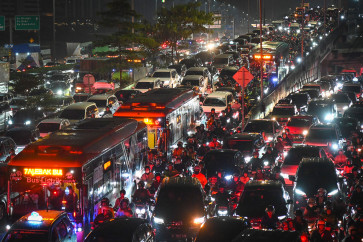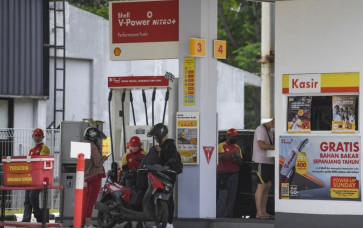Popular Reads
Top Results
Can't find what you're looking for?
View all search resultsPopular Reads
Top Results
Can't find what you're looking for?
View all search resultsSunda Strait flights, shipping disrupted
Grim task: Search and rescue team members scour Carita Beach for victims of the Sunda Strait tsunami in Pandeglang, Banten, on Thursday
Change text size
Gift Premium Articles
to Anyone
G
rim task: Search and rescue team members scour Carita Beach for victims of the Sunda Strait tsunami in Pandeglang, Banten, on Thursday. Saturday’s tsunami, which was triggered by eruptions from Anak Krakatau, is reported to have killed 430 people and injured 1,495. As many as 159 people are missing, with 21,991 others displaced.(JP/Dhoni Setiawan)
Aircraft and vessels traversing the Sunda Strait have been diverted by the eruptions of Anak Krakatau, a volcano in the middle of the strait that is continuing to spew lava and columns of ash.
Passengers on flights between Sumatra and Java can expect delays as authorities reroute flights around the erupting volcano, days after it triggered a devastating tsunami that killed over 400 people.
Indonesian Flight Navigation Service (AirNav) issued a notice to airmen (NOTAM) warning not to fly through certain waypoints affected by Anak Krakatau’s eruptions and to take different routes as the volcano ash reached red-alert level.
Although the travel times of some domestic and international flights have been affected, the operations of all airports in the country remain normal, AirNav president director Novie Riyanto said.
“Airplanes can still fly as usual, but some delays are expected […] we need to divert flights from
the ash-affected routes,” Novie told The Jakarta Post on Thursday.
The most-affected domestic flights, Novie said, were those departing from Sumatra, while international flights that needed to make small detours included flights from Singapore, Bangkok and Kuala Lumpur.
Alternative routes for the planes include waypoints across the Java Sea or the Indian Ocean west of Java Island, he said without detailing the number of affected flights.
“No flights will be diverted to alternative airports,” he said.
The Volcano Observatory Notice for Aviation (VONA) issued a code red alert for Anak Krakatau on Thursday as a result of the ongoing eruptions and ash emissions, with ash clouds reaching up to 7,338 meters above sea level and moving northeast.
It came as the alert level for Anak Krakatau was raised to the second-highest level because of increased volcanic activity following months of eruptions since June. The danger zone has been expanded to a 5-kilometer radius from the crater from the previous 2-km radius.
All ships passing the Sunda Strait have been cautioned not to sail close to the island of the volcano and are urged to remain vigilant amid eruptions and extreme weather conditions, the Sea Transportation Directorate General at the Transportation Ministry said in a circular, which remains effective until Jan. 1.
People living in the areas affected by descending ash have been advised to wear face masks and eye protection outdoors.
The Energy and Mineral Resources Ministry’s Geology Agency reported that the volcanic activity had changed from the previous Strombolian eruptions — relatively mild blasts of lava —to the Surtseyan type of eruption caused by the interaction of lava and water, which can be more explosive. Surtseyan eruptions typically occur in shallow seas or lakes.
In Strombolian eruptions, volcanic material is emitted from the top crater, while in Surtseyan eruptions, flowing magma contacting water causes fragmentation that results in
jets of fine-grained ash, said Antonius “Purbo” Ratdomopurbo, the secretary of the Geology Agency.
Thomas Giachetti, a volcanologist from the University of Oregon in the United States and one of four authors who published a 2012 study warning of the possibility of a tsunami resulting from an Anak Krakatau flank collapse, said “it’s better to consider that the volcano is unstable and might collapse again”.
Purbo said, however, there was no way a Surtseyan eruption could cause another flank of Anak Krakatau to collapse. A collapsing flank is believed to have caused Saturday’s tsunami,
when a 64-hectare section of the volcano collapsed and caused a landslide large enough to generate massive waves that struck coastal towns along the Sunda Strait.
Anak Krakatau emerged in 1928 from the remnants of the 1883 eruption of Mount Krakatau. The 90-year-old volcano has been particularly active this year, spewing volcanic material and sending clouds of ash up to 3,000 meters into the sky.










